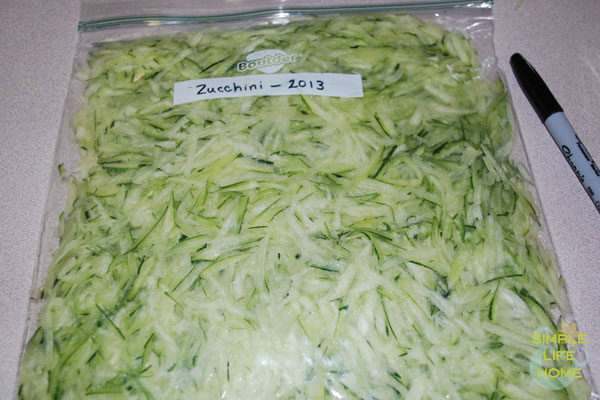
If you’re like most people who have ever grown a garden, you’ve probably tried your hand at growing zucchini at some point along the way. It’s a very rewarding plant to grow, since it usually produces well in any type of climate and typically claims a spot as the top producer in your garden.
The trouble comes when you start harvesting more zucchini than you know how to handle. After all, this isn’t a grocery store in your backyard. You can’t ignore all those beautiful plants just because you don’t want to cook zucchini tonight. You have to pick it when it’s ripe, even if you don’t plan to use it right away. That’s why it’s helpful to know how to freeze zucchini.
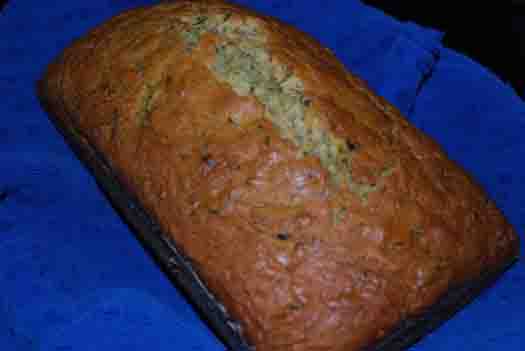
I started freezing my zucchini a couple of years ago. I primarily grow zucchini for zucchini bread, although I do enjoy it in a zucchini pie, which is a fantastic dish to serve at a ladies’ brunch or for lunch with a friend.
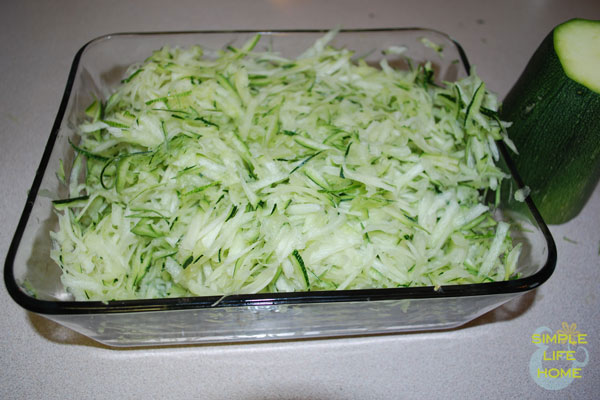
To freeze the zucchini, I simply shred what I need for a batch of zucchini bread, seal the shredded zucchini in a plastic freezer bag, then pull it out whenever I want to bake some bread. As a side note, I’ve also used shredded zucchini in soups. It’s a great thickener, and it adds a nutrition boost to any soup you make. I particularly like it in chicken and wild rice soup. Yum!
So here’s how to freeze zucchini, in four simple steps.
Step 1: Rinse the zucchini thoroughly. My zucchini comes straight from the garden, and if it’s been rainy at all, the end is typically caked in mud. Since the bread recipe calls for the rind as well as the pulp, you want to make sure the outside is really clean.
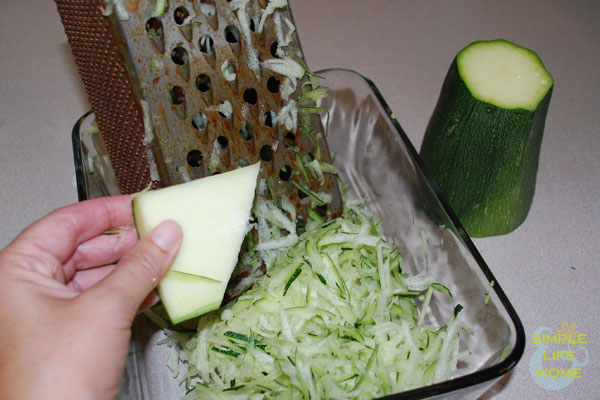
Step 2: Shred the zucchini. This would be much easier if I owned a food processor, but since I don’t, I whip out my old-fashioned grater and go to town. It helps if I can conscript the services of a child or two for this job, especially if I have a lot of zucchini to freeze.
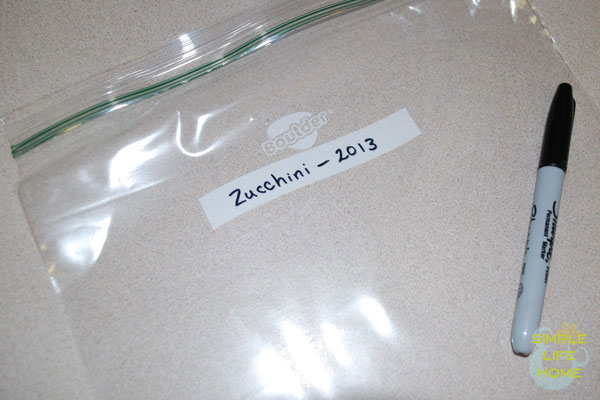
Step 3: Mark a freezer bag with the date and contents, then fill it with enough zucchini to make your bread recipe. I always double the amount, since the zucchini will get watery during thawing.
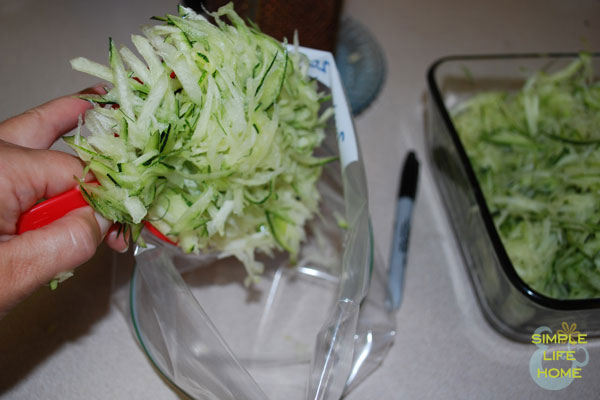
Since my recipe calls for 2 cups of zucchini, I fill a gallon-sized freezer bag with 4 cups of shredded zucchini, making sure to turn down the top of the freezer bag when filling to help the bag stay upright and keep the zucchini from covering my counters. (You might think from these photos that this is a lost cause, but trust me, it could be sooo much worse!) 🙂

Step 4: Remove as much air as possible from the bag, seal, flatten, and freeze.
Thawing tip: The zucchini thaws pretty fast, especially if you put the bag of frozen zucchini (sealed) in a sink filled with warm water. You will lose about half the volume in water, and you’ll want to drain this excess liquid before adding the zucchini to your recipe, unless you want really soggy bread! Doubling the amount for the recipe when freezing makes up for this water loss.
And that’s all there is to it! Happy freezing!

Doesn’t squeezing the water out remove the vitamins?
Great question! It looks as if the jury is still out on this one. Some people suggest that (after cooking, at least), some vitamins and minerals leach into the water. These folks recommend saving the cooking water and using it in soups as a way to reclaim some of the vitamin content. See: http://www.livestrong.com/article/465595-do-vegetables-lose-nutrients-when-cooked/
Others suggest that, after draining, the mineral density of the food actually increases. http://cooking.stackexchange.com/questions/28663/nutrient-impact-of-squeezing-water-out-of-frozen-chopped-spinach
Unless you are only planning on cooking with and/or baking the zucchini during growing season, you are bound to lose some vitamin content, either because you process your own veggies, typically right after you pick them, or because the stuff you buy in the store will likely have been picked days before and shipped to the store. I always choose my own produce, whenever possible, since I know what I added to the soil or didn’t apply to the plant (pesticides.) 🙂
I do this but mine is really watery when I thaw it. How can I keep it from getting watery?
You can keep it from getting watery by adding salt before you freeze it. Here are a couple of sites I’ve looked at and considered. https://www.google.com/url?sa=t&rct=j&q=&esrc=s&source=web&cd=1&cad=rja&uact=8&ved=0ahUKEwiy4OXMrLbNAhUDOlIKHT2ABJEQFggeMAA&url=http%3A%2F%2Fwww.popsugar.com%2Ffood%2FSalt-Watery-Vegetables-Before-Cooking-11379955&usg=AFQjCNGoQrOFI-CJL7M6amFr9xLYfR2FbQ
http://www.finecooking.com/articles/zucchini-loves-high-heat.aspx
In the end, I decided I didn’t want the extra salt in our diets, so I just double the amount of zucchini that my baking recipe calls for, drain it after it’s thawed, and let it go at that. It has always worked out just fine, and without the extra salt.
Would you share your bread recipe?
Sure! Here’s a link: https://www.simplelifeandhome.com/2012/07/12/award-winning-zucchini-bread/
If you spread the shredded zucchini on a cookie sheet and freeze it, then take it out and put it in the freezer bag for long term storage, it won’t stick together in a big clump, and you can just reach into the bag and take out however much you want. That would be helpful if you are using it for soups, smoothies, etc. For bread it wouldn’t matter, since you would be using the whole bagful.
So you don’t try to get some of the water out by salting it or anything? It just seems that it would be mushy.
Hi, Kim. I have seen that some people squeeze the excess water out of the zucchini before freezing it, but I prefer to put twice as much zucchini as my recipe calls for in my freezer bag and then drain the extra liquid. It really isn’t too mushy when thawed, and I prefer this method, especially for baking bread, because I want to avoid the extra salt in the food.
How long can you keep zucchini frozen?
I have used shredded zucchini in bread and soup recipes that has been stored in my freezer for up to a year.
I find the food processor shredder disk works great if you have a ton of large baseball bat sized zucchini to process. Also, we like to throw some chocolate chips into the batter before pouring and baking!
Sounds yummy!